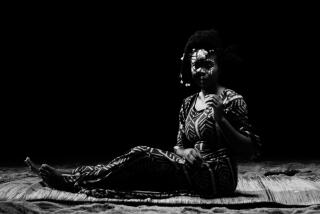Bamana Exhibition Reflects the Nature of Life in Mali
- Share via
NEW YORK — For the Bamana people of West Africa, the power of nature is tapped by kicking up the dust and making noise, bringing along brightly painted puppets and awe-inspiring masks to harness positive energy, rein in chaos and keep evil at bay.
Through almost 100 objects and photos and a half-dozen videos, “Bamana: The Art of Existence in Mali,” at the Museum for African Art in Manhattan, takes an unprecedented look at a Malian art, culture and religion that in many ways is a paradigm for other West African traditions.
“Basically, they believe that everything contains a force--nyama,” said Frank Herreman, who organized the show with photographer Catherine de Clippel and anthropologist-filmmaker Jean-Paul Colleyn.
“Nyama is in everything, and if you have nyama in you and you can spread it out you become an important person. If you can manage the nyama which is in the things around you, you become a very powerful person indeed.
“The real art of living is mastering the forces that are in nature,” Herreman said, explaining that, for the Bamana, art, culture, society and religion are intertwined. “The show goes from the public to the secret. When you come into the exhibition, it’s like stepping into a village in the Bamana region” in southwestern Mali.
The exhibition allows visitors to glimpse Bamana artistic language through ritualistic and practical objects, most from the 19th and 20th centuries but some as old as the 15th century.
“You see some ceramics; you see the iron staffs, which are carried by leaders. Then you go into the social organizations and you see that young boys’ and girls’ organizations exist to create a social tolerance in the community,” he said. “And there are the organizers of the puppet theater.”
Gallery by gallery, visitors delve deeper into the spiritual world of the Bamana, where replacing negative with positive forces is paramount.
Wooden puppets painted in brilliant reds and blues dramatize local social issues and are carried through the village as part of a social-spiritual drama in which participants move, dance, kick up dust, make noises and create short skits.
One puppet from the 1960s (a time when African nations were gaining independence) shows what is probably an image of French President Charles de Gaulle with his head in a chicken’s feathery tail. Today, similar puppets are more likely to illustrate problems such as AIDS.
“One thing you should never forget is that these masks and theater are very close, and they have to make a dramatic appearance. If you’re a Roman Catholic, you have churches, and the churches contain statues of saints that are used to help inspire,” Herreman said. “But what happens when suddenly that spirit becomes alive? That’s what a mask does. It’s like a saint, but it dances and moves. It goes through the community, and you’re not quite sure what it’s going to do. That’s very important.”
Nyama, or life force, is also activated through the mastering of secret knowledge that the Bamana find in initiation societies. Consequently, all artworks created for ritual purposes contain nyama. Sculptures of shapely women introduce the Bamana to sexuality and fertility. Bulky wooden masks of hyenas or paint-speckled lions help the elderly come to terms with death.
A powerful form believed to sustain energies of huge force under enormous pressure is found in the boliw, an intimidating sculptural form vaguely resembling a buffalo. It is molded from vegetation and soil and coated with layers of blood, hair and other organic substances.
The show ends with a display of elegant antelope headpieces--Ci-wara--worn strapped to the head as part of an elaborate costume in agricultural rituals. They are often made in pairs, with male and female versions.
“They’re about learning how to manage the land. This Ci-wara is in a way a supernatural being that is incarnated as an animal to teach you how to survive.”
The show, composed of works on loan from various U.S. collections, is on view through March 3. A version of the exhibit featuring pieces from European collections is at the Rietberg Museum in Zurich. After New York, the show is set to travel nationally and internationally.
More to Read
Sign up for The Wild
We’ll help you find the best places to hike, bike and run, as well as the perfect silent spots for meditation and yoga.
You may occasionally receive promotional content from the Los Angeles Times.






